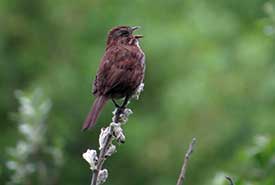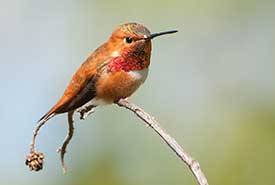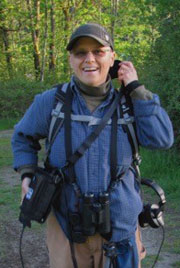Eavesdropping on silence

A song sparrow sings at Chase Woods. (Photo by Ren Ferguson)
Have you ever stood in the middle of a field or forest and tried to listen to the silence? Once you have stilled your mind's voice and relaxed into the present, the silence of nature will become rather noisy. But our human ears can catch only a fraction of the audio hustle and bustle of the natural world. To really tune in, we need the help of high-end audio recording technology.
Ren Ferguson is an acoustic ecologist who used highly sensitive sound recordings to discover and confirm what wildlife are present in a natural area, as well as how dense their populations are. Perhaps not surprisingly, these recordings focus largely on bird species, though other creatures, including insects, amphibians and mammals, can also be detected on the recordings.
"You can gather an incredible amount of information about any given location through sound," says Ren, an avid birder who has been interested in acoustic ecology for a decade and has been recording with her own equipment for the last four years.

Rufous hummingbird (Photo by Stuart Clarke)
Listen: The sounds of the Chase Woods Nature Preserve
Note: At 4:10 and 4:17 you can hear a territorial rufous hummingbird making its fighter-pilot-like mating calls.
We are noisy creatures
Capturing natural soundscapes at the level that Ren does requires high-frequency super-sensitive microphones. The microphones are so finely tuned that they capture distant sounds that we normally filter out, such as traffic or a plane passing overhead. When you listen to the recordings it is impossible to ignore the noise we create and have become accustomed to.
"The unfortunate side of soundscape recording in our world right now is how ubiquitous human influence is," says Ren. "We are really noisy!"
Acoustic ecology reveals just how rare it is to find a patch of Earth that does not bear some imprint of human presence.
Help from robots

Ren Ferguson
Ren also promotes the benefits of autonomous recording units (ARU), which are installed and programmed to collect massive amounts of data on their own.
"Having biologists in the landscape 24/7 is impossible," she points out, adding that many species will remain silent in the presence of a human technician. An ARU is also useful when surveying for nocturnal species, such as western screech owl.
What we can learn from sound
Audio recordings are proving very useful in revealing changes over time within a given landscape. They can provide important information to help land managers adapt stewardship practices to best support biodiversity. They also offer a unique way to share the importance of a conservation area to people who might not be able to visit it first-hand.
"These high-quality stereo recordings provide an immersive experience for the listener, which are much more powerful than bird lists and numbers," says Ren. "People 'get it' when they hear the sounds of a place."
Ren has been making recordings on a few Nature Conservancy of Canada conservation areas. At the Chase Woods Nature Preserve on Vancouver Island, Ren is documenting the soundscapes before, during and after a large wetland restoration project. She expects the site will attract waterfowl and is hopeful to hear also some shorebirds in the coming years. Her audio recordings will allow us to monitor the impact of the restoration work.
Ren has also made recordings at the nearby Cowichan Garry Oak Preserve and at the Sage and Sparrow Conservation Area in the South Okanagan.




